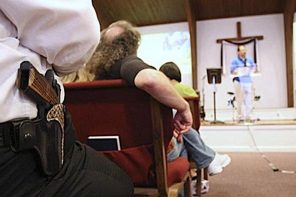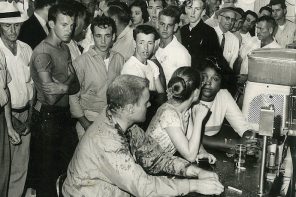There have times during the last year when the most important political figure in the United States seemed not to be Barack Obama, but Abraham Lincoln. In his deft review of a number of new books on Lincoln (all released to coincide with the bicentennial of Lincoln’s birth), Ari Kelman observes that the 2008 election seemed at times to be a referendum on who could claim the mantle of the sixteenth president. Obama shrewdly promoted this storyline from the announcement of his candidacy on the steps of the Illinois statehouse to his swearing in using the same Bible upon which Lincoln took the oath of office. Even in the midst of the Great Recession, the Lincoln industry has had a boom year.
The apotheosis of Lincoln, of course, has a long history. Martyred on Good Friday, Lincoln was quickly rendered in popular illustrations that showed him being whisked into heaven. However, there remained a significant group of dissenters, mostly from the South, who held onto a much more secular (and negative) version of the slain president. In the first of his two volumes scrutinizing the shifting images of Lincoln in American popular culture, Barry Schwartz points out that Lincoln biographies did not sell well in the late nineteenth century; and that the “Lincoln entrepreneurs” of the period had a difficult time persuading their contemporaries of his greatness. It was not until the Lincoln centennial of 1909 and the arrival of the Progressive Era, says Schwartz, that Abraham became Saint Lincoln.
A Cutthroat Pol
If I sound more interested in the afterlife of Lincoln, the way that he circulates in popular memory, than in his actual history, it may be because I’m an English professor. At least, that is one of the conclusions I had to reach after reading Sean Wilentz’s 25,000-word New Republic cover story on Lincoln and Lincoln scholarship. If you can get a national magazine to publish something of that length, you deserve a more careful reading than a one-sentence summary. But here’s the short version: Lincoln was a politician, and English professors are wretched historians.
Wilentz’s argument is that the contemporary version of Lincoln that most Americans carry with them now has stripped him from the fractious politics of his time. We have made Lincoln into such a principled, divine figure that we have robbed him of the spectacular political feats that he performed, deft negotiations that make Bill Clinton’s triangulations look like child’s play. We then become regularly shocked to find that Lincoln was, first and last, a cutthroat pol who could spin with the best of them.
The most egregious sinners on this score, Wilentz writes, are the literary scholars who seek an aesthetic Lincoln, a philosopher-king of ideological purity. Since they can’t read history properly, these wordhounds proceed to make a series of fallacious judgments, often deeming Lincoln wanting in comparison to more doctrinaire abolitionists. If you think Henry Louis Gates Jr. had a rough time with the Cambridge police, you should see what Wilentz does to him.
I picked up Wilentz’s essay as I was traveling to the Abraham Lincoln Presidential Library and Museum in Springfield, and I kept wondering if Wilentz had made the trip as well. True to my calling, I guess, I skipped the scholarly research center and spent my time in the lavish exhibits of the museum half of the enterprise. The Lincoln Museum opened in 2005, and it is full of the high-tech wizardry that has come to be a staple of museum experiences. Theaters show three-dimensional films with floors that shake and cannons that spout real smoke. A meticulous reproduction of Lincoln’s log cabin houses the reclining, almost sulking, future president trying to read by firelight. And no presidential museum would be complete without the gowns of the first lady. (At least this one also includes the figure of her seamstress and confidante, the former slave Elizabeth Keckly.)
It would be unreasonable to expect any presidential museum (let alone a Lincoln museum) to escape the trap of hagiography, and this one does not disappoint on that score. You can follow each of the vignettes of Lincoln’s life as though it were a Pilgrim’s Progress stocked with wax allegories of virtue. You can sit in a small amphitheatre and “Ask Mr. Lincoln” questions great and small, from his family background to the difference between good and evil to his reputed family connection to Tom Hanks.
When the visitor tires of simulacra, there are relics bathed in soft light and held apart with sacred reverence: a stove-pipe hat, pages of Lincoln’s writing, his presidential seal. However, the pinnacle of Lincoln worship comes with the chance to mourn his death in a “nearly full-scale” reproduction of his lying in state in the Illinois statehouse in May 1865. With dark, velvet curtains hanging from the wall and a soft serenade of an elegiac choir, you can almost smell the overwhelming sweetness of the memorial bouquets. I can’t put it any better than the museum’s own Web site: “Having walked through Lincoln’s life, you will now file past the closed casket as though you too are paying your last respects.”
But as much as the museum invites visitors to participate in the canonization of Lincoln that has been in progress for a century and a half, it also uses a full repertoire of technological tricks to remind us of his political dimension. One of the best-known exhibits presents a Tim Russert special on the Election of 1860, presenting television ads for each of the four candidates using our contemporary campaign idiom: a kind of “Meet the Press” meets the History Channel. The “whispering gallery” is a crooked passageway lined by political cartoons placed with frames askew, as speakers play voices wickedly enjoying scurrilous gossip about the newly-elected president. (Point made: The birthers are not a new phenomenon.) And the gallery leading up to the signing of the Emancipation Proclamation features an array of holographic faces from all walks of life shouting at President Lincoln; sometimes to do more, but mostly to do a good deal less for enslaved Americans. (Point made: Neither are tea parties.)
Of course, all of these exhibits simplify the politics of Lincoln’s time. What they give us, though, is a sense of a leader under extraordinary pressures. They lead us back to the man who carefully couched his public statements so that he could find room to maneuver among a coalition of supporters that threatened to shatter the broken nation into even smaller pieces. Unfortunately what is missing is a way to connect Lincoln-the-divine with Lincoln-the-pol, the man of principle with the man of shrewd calculation. The cacophony of voices urging him to sign the Emancipation Proclamation (as well as some urging for a truly national emancipation that would have included the border states) demonstrates the difficult path that Lincoln took, but it doesn’t really explain why he took it. All the museum gives us in this regard is a wan generalization that Lincoln believed “all men should be free.” If that were sufficient, he would have signed the Proclamation upon entering office instead of waiting for over a year of the bloodiest war in his nation’s history.
What we need (and I fear my literary training will rear its head one last time) are public ways of linking the poetry and the prose of leadership. We need a Saint Lincoln who creates the secular creed of the Republic, but we also need partisan Lincoln who spars with newspaper editors, party hacks, and rumormongers. Moreover, I learned from the Lincoln museum that the public wants both of these figures—and not just as a study in contrasts to set side-by-side. Instead, we must learn to grapple with the fact that the national savior and the ruthless pol could be joined in a single man.
Given the recurring violence of our contemporary political discourse, it is hard to avoid making yet another link between Lincoln’s time and our own. Whether or not Obama will prove to be Lincolnesque is hard to say, but this is hardly the first time that we have had a leader who has aspired to both principle and pragmatism. This is not the first time we have elected an orator whose policies have often left his followers disappointed. Nor is this the first time that an American president has been the object of mass scorn, revulsion, and open hatred for threatening the “American way of life.” On all counts, we have been here before.



